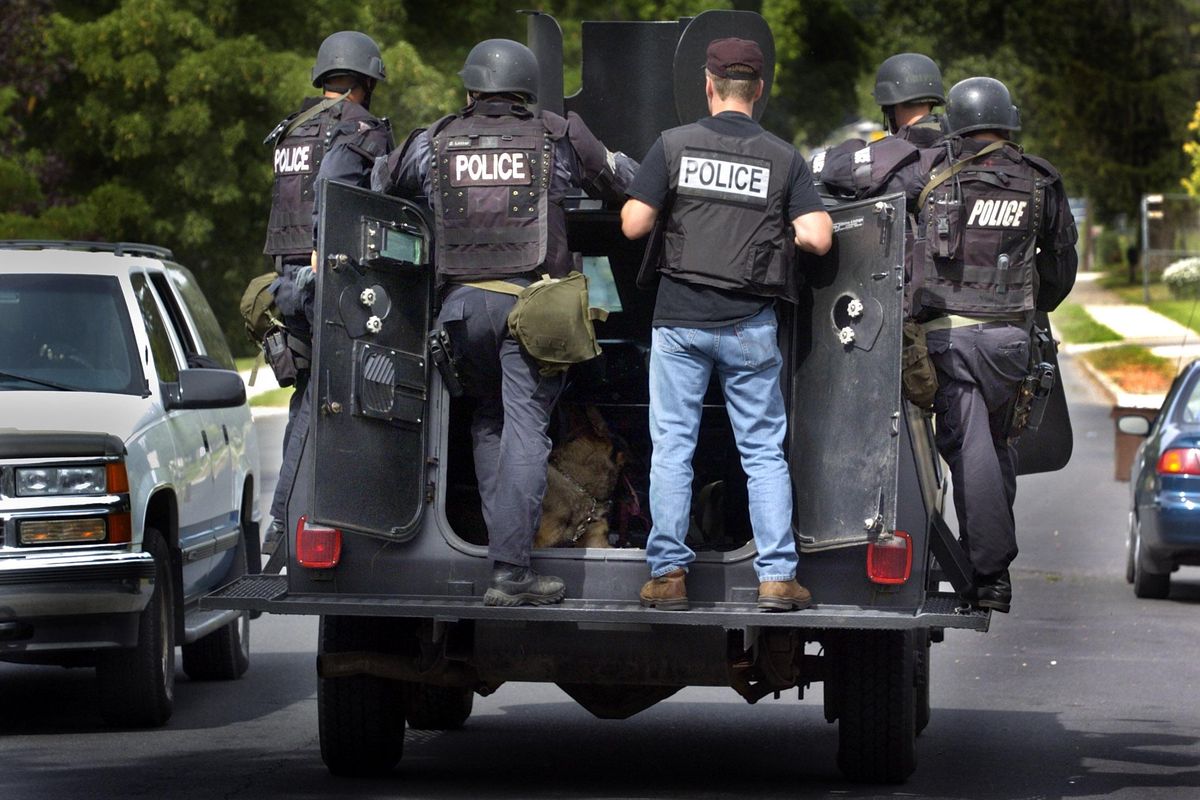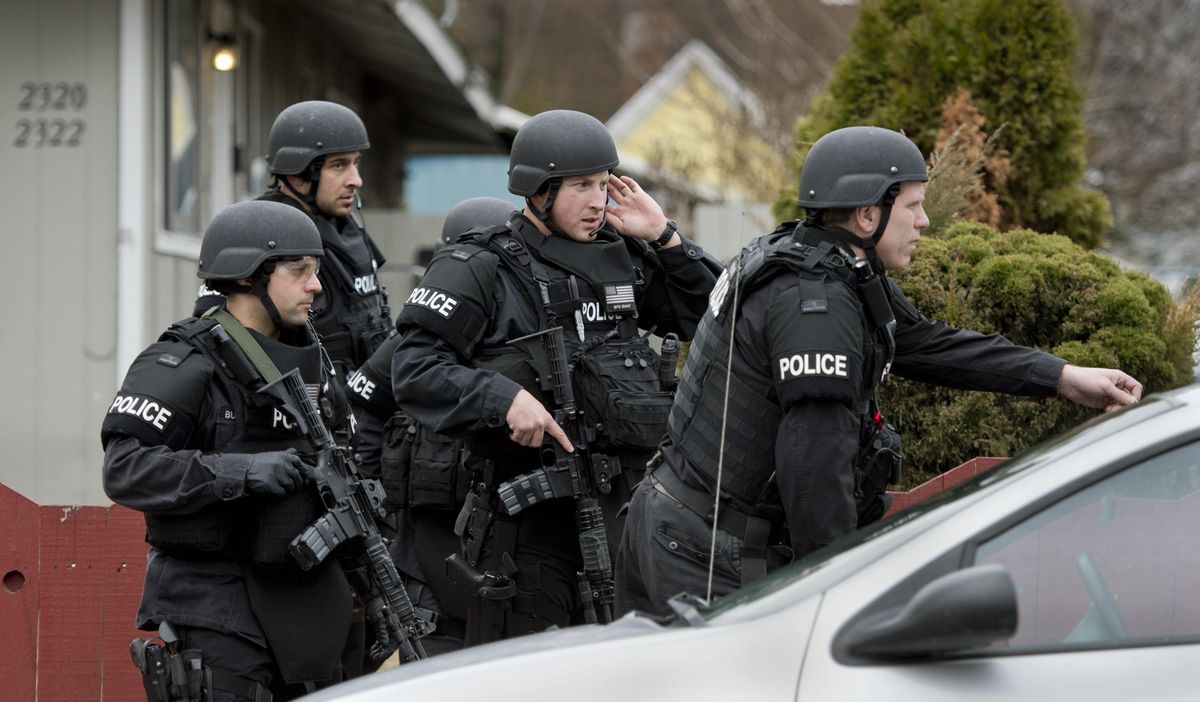Use of SWAT team increasing in Spokane
Lt. Steve Wohl of the Spokane Police Department talks about the small increase in the use of the department’s SWAT team over the past decade. (Jesse Tinsley / The Spokesman-Review)Buy a print of this photo
Local law enforcement agencies are deploying SWAT teams more often than they used to – a practice they say protects officers and citizens alike.
The trend was highlighted this week when a shootout wounded a Spokane County SWAT commander and left a domestic-violence suspect dead in his Colbert home. And it aligns with an increase in SWAT activity nationwide, which has prompted concerns about the militarization of local police forces.
The Spokane Police Department deployed its SWAT team 630 times from 2000 through 2015, according to data provided by the department. On average, SWAT activity trended upward by about two calls each year during that period.
Total deployments peaked with 63 calls in 2015, the last year for which data are available. That’s roughly one call every six days.
“I would venture to say a lot of it has to do with population,” said Lt. Steve Wohl, who has led the police department’s SWAT team for about three years. “It has to do with the amount of weapons that are out there, that we have to deal with to make it safe for people. There’s all kinds of different factors that play into why SWAT is called.”
Wohl said the department voluntarily compiles annual figures representing several categories of SWAT activations.
The vast majority of calls involved at least one suspect who was believed to be dangerous, according to the department. More than half – 354 – were categorized as “high-risk warrant service.” And 207 were labeled “tactical operations,” in which a person was armed and suicidal, or had taken a hostage. Wohl said mental illness often plays a role.
The police SWAT team also assisted other law enforcement agencies and provided security for more than two dozen events, including Bloomsday, the Lilac Parade and several presidential campaign rallies.
The Spokesman-Review could not immediately obtain a more detailed set of data including criminal charges, incident descriptions and suspects’ names and addresses.
The Spokane County Sheriff’s Office has its own SWAT team that shares some resources with the police department, including a $200,000 Lenco BearCat armored vehicle. It was the sheriff’s SWAT team that engaged in a standoff Monday night at the Colbert residence of 47-year-old Dean J. Bellamy.
Deputy Mark Gregory, a spokesman for the sheriff’s office, said the agency doesn’t maintain a comprehensive list of SWAT activations. But he reviewed calls from the last three years and said the sheriff’s office deployed its SWAT team at least 45 times in 2014, 30 times in 2015 and 37 times in 2016.
Gregory said the sheriff’s SWAT team probably sees more action these days because of policy changes designed to protect deputies and others in the vicinity. When they have good reason to believe a suspect is armed and dangerous, simply knocking on the front door is a bad idea, he said.
“If you look at past shootings, most of them are because there wasn’t time to plan, and there wasn’t time to get our equipment out there before things got out of hand,” Gregory said.
The American Civil Liberties Union has taken a stand against what it considers “the excessive militarization of American policing,” with SWAT raids disproportionately targeting communities of color, often in search of small amounts of drugs.
The federal government doesn’t track how often local police departments deploy their paramilitary units. But according to Peter Kraska, a criminology professor at Eastern Kentucky University, the number of SWAT raids per year grew from about 3,000 in the early 1980s to about 45,000 in the mid-2000s. He estimates that such raids now occur between 50,000 and 80,000 times every year.
“The trend-line demonstrated that this growth began during the drug war of the late 1980s and early 1990s,” Kraska wrote in a 2007 study.
Wohl, of the Spokane Police Department, said the agency’s SWAT team has 27 members including himself. Most of them are detectives or patrol officers or fill another role in the department, and one manages SWAT logistics full-time.
Sometimes they’re called out en masse to deal with a suspect barricaded in a home in the middle of the night, and sometimes a few are briefly pulled away from their regular duties to execute a search warrant, Wohl said.
The cost of such events ranges widely, he said, because of differences in overtime pay and which resources are used. Each year, the department rotates its inventory of materials such as flashbang grenades, which have expiration dates set by the manufacturer.
Officers check boxes on a risk-assessment form to help determine when SWAT capabilities are necessary. One box indicates whether the suspect has a violent history. Others indicate whether the suspect has guns or if there are “guard dogs” on the property.
When the SWAT team bursts into a home, Wohl said, “usually most people are cooperative once we make that entry, and rarely are we finding people that fight us. But it does happen once in a while.”
Monday’s shooting marked the third time the sheriff’s SWAT team had been called to Bellamy’s home in Colbert. He had a history of mental illness and had repeatedly threatened to kill himself or others.
The sheriff’s office hasn’t named the injured SWAT commander but said he is expected to recover after having a bullet surgically removed from his shoulder.



